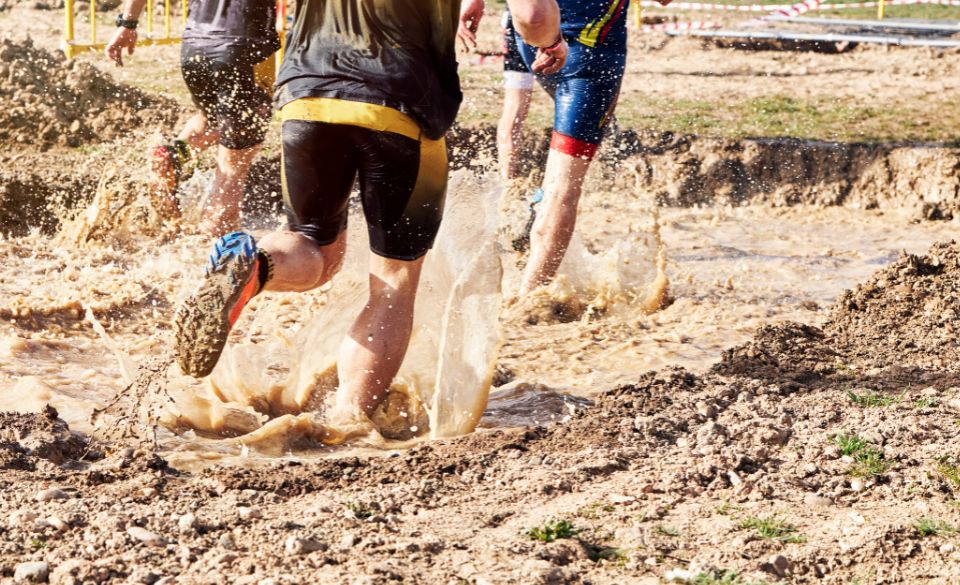
How Do You Train For A Spartan Race: Training Tips for Success
Page Contents
Are you ready to take on the ultimate challenge of a Spartan Race? Whether you’re a seasoned athlete or a fitness enthusiast looking for a new adventure, training for a Spartan Race requires a strategic approach. The intense obstacles, demanding terrain, and mental toughness needed to complete the race make it a true test of endurance and strength. But fear not! In this article, we’ll explore some valuable training tips to help you conquer the Spartan Race and emerge victorious.
How Long Should You Train for a Spartan Race?
So, you’ve decided to take on the exhilarating challenge of a Spartan Race. Now, the question arises: How long should you train to prepare yourself for this demanding event? The duration of your training will depend on various factors, including your current fitness level, the race distance you’re aiming for, and your specific goals. In this article, we’ll explore some general guidelines to help you determine the ideal training duration for a Spartan Race.
Assessing Your Fitness Level
Before diving into a specific training timeline, it’s important to assess your current fitness level. Are you an experienced athlete or relatively new to fitness? Have you participated in similar endurance events in the past? Evaluating your baseline fitness will give you a starting point and help you understand your strengths and areas that need improvement. If you’re new to fitness or have been inactive for a while, it’s recommended to start with a longer training timeline to allow your body to adapt gradually.
Consider the Race Distance
Spartan Races offer various distances, ranging from the Sprint (3-5 miles) to the Super (8-10 miles) and the Beast (12-14 miles). The distance you choose will impact your training duration. Generally, the longer the race, the more time you’ll need to prepare. If you’re a beginner, it’s wise to start with a Sprint and gradually progress to longer distances in subsequent races. For a Sprint, a training period of 8-12 weeks can be sufficient. If you’re aiming for a Super or Beast, it’s recommended to extend your training timeline to 12-16 weeks to adequately build your endurance and strength.
Setting a Training Timeline
Once you’ve assessed your fitness level and determined the race distance, it’s time to establish a training timeline. As a general guideline, aim for a minimum of 3-4 workouts per week. Your training should include a mix of cardiovascular exercises (such as running, cycling, or rowing), strength training, and obstacle-specific drills. Gradually increase the intensity and duration of your workouts over time to avoid overexertion and minimize the risk of injury.
Adaptability and Individual Factors
While the suggested training timelines can serve as a starting point, it’s crucial to listen to your body and be adaptable. Everyone’s fitness journey is unique, and factors like age, previous injuries, and lifestyle commitments can influence your training duration. If you feel your progress is slower or faster than anticipated, adjust your training timeline accordingly. Be patient with yourself and prioritize rest and recovery to allow your body to adapt and grow stronger.
Training for Your First Spartan Race
Embarking on this thrilling adventure requires a well-rounded training plan to prepare your body and mind for the challenges ahead. If you’re wondering how to start training for a Spartan Race, this article will guide you through the essential steps to kickstart your journey.
Set Clear Goals and Commitment
The first key to success is setting clear goals for your Spartan Race. Determine what you want to achieve, whether it’s completing the race, improving your personal best, or tackling specific obstacles. Once you have your goals in mind, commit to your training plan and make it a priority. Consistency and dedication are crucial for building endurance, strength, and mental resilience.
Cardiovascular Endurance: Lace Up Those Running Shoes
Running is a fundamental component of Spartan Race training. Begin by establishing a running routine to build cardiovascular endurance. Start with shorter distances and gradually increase your mileage over time. Include a mix of steady-state runs, interval training, and hill sprints to mimic the race’s terrain. Incorporate varied running surfaces, such as trails or stairs, to enhance your adaptability and endurance.
Strength and Functional Training: Conquer the Obstacles
Spartan Races are known for their challenging obstacles. Strengthening your body is vital to overcome these obstacles successfully. Incorporate strength training exercises that target your upper body, core, and lower body. Pull-ups, push-ups, squats, lunges, planks, and burpees are fantastic exercises to include in your training routine. Incorporate both bodyweight exercises and weightlifting to build functional strength.
Obstacle-Specific Training: Practice Makes Perfect
To tackle Spartan Race obstacles with confidence, it’s essential to incorporate obstacle-specific training. Identify the key obstacles you’ll encounter in your race distance and dedicate time to practice them. Rope climbs, wall traverses, monkey bars, and bucket carries are just a few examples. If possible, find a training facility or outdoor course that mimics these obstacles to gain hands-on experience.
Mental Resilience: Train Your Mind
Preparing for a Spartan Race isn’t just about physical strength; mental resilience is equally important. Train your mind to push through fatigue, overcome challenges, and stay focused during the race. Practice visualization exercises, positive self-talk, and mindfulness techniques to develop mental toughness. Embrace discomfort during training and remind yourself of your goals to stay motivated and resilient.
Gradual Progression and Rest Days
As you embark on your training journey, remember the importance of gradual progression and rest days. Avoid pushing yourself too hard too soon, as it increases the risk of injury and burnout. Gradually increase the intensity and duration of your workouts, allowing your body time to adapt and recover. Incorporate rest days to promote muscle repair and prevent overtraining.
Join a Community and Have Fun
Training for a Spartan Race is more enjoyable and motivating when you’re part of a community. Consider joining a local training group, connecting with fellow racers online, or participating in Spartan Race-specific events. Sharing experiences, tips, and challenges with others can provide valuable support and encouragement.
12-Week Training Plan for Your Spartan Race
To ensure you’re fully prepared for your upcoming Spartan Race, it’s essential to follow a structured training plan. The following 12-week plan is designed to gradually build your endurance, strength, and mental resilience, enabling you to conquer the challenges that await you on race day. Remember to adjust the plan based on your current fitness level, race distance, and individual needs.
Week 1-4: Building a Solid Foundation
During the first four weeks, focus on building a solid foundation of cardiovascular endurance, strength, and overall fitness.
Running: Incorporate three to four runs per week, alternating between steady-state runs and interval training. Start with shorter distances (e.g., 2-3 miles) and gradually increase to 4-5 miles by the end of Week 4.
Strength Training: Perform two to three strength training sessions per week, targeting your full body. Include exercises such as push-ups, pull-ups, squats, lunges, planks, and kettlebell swings. Aim for two to three sets of 10-15 repetitions for each exercise.
Obstacle-Specific Training: Dedicate one session per week to practicing specific obstacles you may encounter in your race. Focus on rope climbs, wall traverses, monkey bars, and other key challenges.
Rest and Recovery: Incorporate one to two rest days each week to allow your body to recover and adapt to the training.
Week 5-8: Increasing Intensity and Endurance
During this phase, you’ll progressively increase the intensity and duration of your workouts to enhance your endurance and strength.
Running: Maintain three to four runs per week. Increase the distance gradually, aiming for 6-8 miles by the end of Week 8. Include hill sprints and trail runs to simulate race conditions.
Strength Training: Continue with two to three strength training sessions per week. Increase the intensity by adding weights or resistance bands to your exercises. Focus on improving your form and increasing the difficulty of bodyweight exercises.
Obstacle-Specific Training: Increase the frequency of obstacle-specific training to twice a week. Challenge yourself to complete obstacles with improved technique and efficiency.
Rest and Recovery: Maintain one to two rest days per week to prevent overtraining and promote recovery.
Week 9-12: Fine-Tuning and Mental Preparation
During the final weeks, fine-tune your training and focus on mental resilience to prepare for race day.
Running: Maintain three to four runs per week, gradually increasing the intensity of your interval training. Incorporate longer distance runs, reaching 10-12 miles by Week 12.
Strength Training: Continue with two strength training sessions per week, emphasizing functional movements and compound exercises. Increase the weights or resistance to challenge your muscles further.
Obstacle-Specific Training: Dedicate at least two sessions per week to obstacle-specific training. Refine your technique, practice transitions between obstacles, and simulate race scenarios.
Mental Resilience: Incorporate mental training techniques into your routine, such as visualization exercises, positive affirmations, and practicing mental toughness during challenging workouts.
Rest and Recovery: Maintain one to two rest days per week, ensuring adequate recovery before the race.
Final Thoughts
Training for a Spartan Race requires dedication, perseverance, and a well-rounded approach that addresses cardiovascular fitness, strength training, and mental toughness. Remember to set clear goals, create a structured training plan, and gradually increase the intensity of your workouts. Stay consistent, listen to your body, and be patient with your progress. On race day, trust in your training, embrace the challenges, and relish the satisfaction of conquering the Spartan Race. It’s time to unleash your inner warrior and embrace the journey that awaits you.




